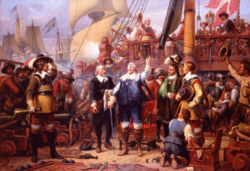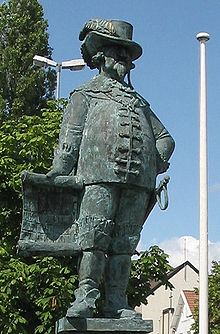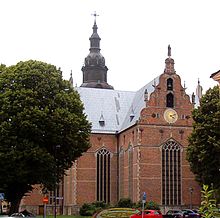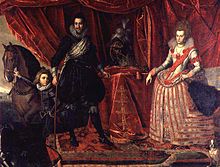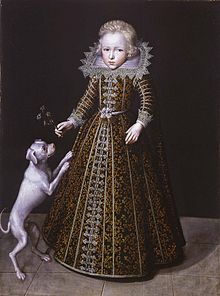- Christian IV of Denmark
-
Christian IV 
Portrait by Pieter Isaacsz, 1611-1616. King of Denmark and Norway Reign 4 April 1588 – 28 February 1648
(59 years, 330 days)Coronation 29 August 1596 Predecessor Frederick II Successor Frederick III Spouse Anne Catherine of Brandenburg
Kirsten MunkIssue Christian, Prince-Elect of Denmark
Frederick III of Denmark
Ulrich, Administrator of the Prince-Bishopric of Schwerin
Sophie Elisabeth Pentz
Leonora Christina Ulfeldt
Valdemar Christian of Schleswig-Holstein
Elisabeth Augusta Lindenov
Christiane Sehested
Hedevig Ulfeldt
Dorothea Elisabeth Christiansdatter
Christian Ulrik Gyldenløve
Hans Ulrik Gyldenløve
Ulrik Christian GyldenløvHouse House of Oldenburg Father Frederick II of Denmark Mother Sofie of Mecklenburg-Schwerin Born 12 April 1577
Frederiksborg PalaceDied 28 February 1648 (aged 70)
Rosenborg CastleBurial Roskilde Cathedral Religion Lutheranism  The coronation of King Christian IV, painted by Otto Bache, 1887.
The coronation of King Christian IV, painted by Otto Bache, 1887.
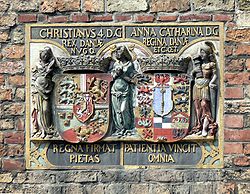 Coat of arms of Christian IV and Queen Anne Catherine. From Kompagnietor, Flensburg.
Coat of arms of Christian IV and Queen Anne Catherine. From Kompagnietor, Flensburg.
Christian IV (12 April 1577 – 28 February 1648) was the king of Denmark-Norway from 1588 until his death. With a reign of more than 59 years, he is the longest-reigning monarch of Denmark, and he is frequently remembered as one of the most popular, ambitious and proactive Danish kings, having initiated many reforms and projects.[citation needed] He is sometimes referred to as Christian Firtal in Denmark and Christian Kvart or Quart in Norway.
Contents
Court life
The son of Frederick II, king of Denmark-Norway, and Sofie of Mecklenburg-Schwerin, he was born at Frederiksborg castle in 1577.[1] He descended, through his mother's side, from king John of Denmark, and was thus the first descendant of King John to assume the crown since the deposition of King Christian II. He succeeded to the throne at the age of 11, on the death of his father on 4 April 1588.[1] While he was still growing up, chancellor Niels Kaas and the Rigsraadet council served as trustees of the royal power. He received a good education, and was a headstrong and talented student.[2] At the age of 18, Christian ascended the throne on 17 August 1596.[1]
On 30 November 1597, he married Anne Catherine of Brandenburg, a daughter of Joachim Friedrich, margrave of Brandenburg and duke of Prussia. The queen died fourteen years later, after bearing Christian seven children. Four years after her death the king privately married a handsome young gentlewoman, Kirsten Munk, by whom he had twelve children — a connection which was to be disastrous to Denmark.[1]
In the course of 1628 he discovered that his wife, Kirsten Munk, was having a relationship with one of his German officers; and when he put her away she endeavoured to cover up her own disgrace by conniving at an intrigue between Vibeke Kruse, one of her discharged maids, and the king. In January 1630 the rupture became final, and Kirsten retired to her estates in Jutland. Meanwhile Christian openly acknowledged Vibeke as his mistress, and she bore him a numerous family. Vibeke's children were of course the natural enemies of the children of Kirsten Munk, and the hatred of the two families was not without influence on the future history of Denmark.[1]
Military and economic reforms
Christian took interest in work of the most various description, including a series of domestic reforms. He also did much for the national armaments. New fortresses were constructed under the direction of Dutch engineers. The Danish navy, which in 1596 consisted of but twenty-two vessels, in 1610 rose to sixty, some of them being built after Christian's own designs. The formation of a national army was more difficult. Christian had to depend mainly upon hired mercenary troops as was common practice in the times—well before the establishment of standing armies—augmented by native peasant levies recruited for the most part from the peasantry on the crown domains.[1]
Up until the early 1620s, Denmark's economy was in great shape due to general high conjunctures in Europe. This inspired Christian to initiate a policy of expanding Denmark's overseas trade, as part of the mercantilist wave that was sweeping Europe. He founded a number of merchant cities, and supported the building of factories. He also built a large number of buildings in Dutch Renaissance style.
However, despite Christian's many efforts, the new economic projects did not return a profit. He looked abroad for new income. Christian IV's Expeditions to Greenland was a series of expeditions in the years 1605-1607 to Greenland and Arctic waterways in order to locate the lost Eastern Norse Settlement and assert Danish sovereignty over Greenland. The expeditions were unsuccessful, partly due to leaders lacking experience with the difficult arctic ice and weather conditions. The pilot on all three trips was English explorer James Hall. An expedition to North America was commissioned in 1619. The expedition was captained by Norwegian navigator and explorer, Jens Munk. The ships, which were searching for the Northwest Passage, arrived in Hudson Bay landing at the mouth of Churchill River, settling at what is now Churchill, Manitoba. However, it was a disastrous voyage with cold, famine, and scurvy destroying most of the crew. He also sent Ove Gjedde to establish Denmark's first colony at Tranquebar, on India's southcoast in 1620, and Christian also assigned the privilege establishing the Danish East India Company.[2][3]
Foreign policy and wars
The Kalmar War
Main article: Kalmar WarIn 1611, he first put his newly organized army to use. Despite the reluctance of Rigsraadet, Christian initiated a war with Sweden for the supremacy of the Baltic Sea.[2] It was later known as the Kalmar War because its chief operation was the Danish capture of Kalmar, the eastern fortress of Sweden. Christian compelled King Gustavus Adolphus of Sweden to give way on all essential points at the resulting Treaty of Knäred of 20 January 1613.[1] However, despite Denmark's greater strength, the gains of the war were not decisive.[2]
He now turned his attention to the Thirty Years' War in Germany. Here, his objectives were twofold: first, to obtain control of the great German rivers— the Elbe and the Weser— as a means of securing his dominion of the northern seas; and secondly, to acquire the secularized German Archdiocese of Bremen and Prince-Bishopric of Verden as appanages for his younger sons. He skillfully took advantage of the alarm of the German Protestants after the Battle of White Mountain in 1620, to secure coadjutorship of the See of Bremen for his son Frederick (September 1621). A similar arrangement was reached in November at Verden. Hamburg was also induced to acknowledge the Danish overlordship of Holstein by the compact of Steinburg in July 1621.[1]
The Emperor's War
The growing power of the Catholics in North Germany in and after 1623 was a threat to the Danish holdings in the Schleswig-Holstein duchies and almost induced Christian to intervene directly in the Thirty Years' War. For a time, however, he stayed his hand. The urgent solicitations of the western powers, and his fear that Gustavus Adolphus should supplant him as the champion of the Protestant cause, finally led him to plunge into war on 9 May 1625.[1] He also feared that Sweden could use a war to further expand their holdings in the Baltic Sea. Christian embarked on a military campaign which was later known in Denmark and Norway as "The Emperor War" (Danish: Kejserkrigen, Norwegian: Keiserkrigen).[4]
He had at his disposal from 19,000 to 25,000 men, and at first gained some successes; but on 27 August 1626 he was utterly routed by Johan of Tilly in the Battle of Lutter.[1] Christian had not thoroughly planned the advance against the combined forces of the Holy Roman Emperor and the Catholic League, as promises of military support from the Netherlands and England did not materialize.[5] In the summer of 1627 both Johan of Tilly and Albrecht von Wallenstein occupied the duchies and the whole peninsula of Jutland.[1]
Christian now formed an alliance with Sweden on 1 January 1628, as he and Gustavus Adolphus shared the reluctance of German expansion in the Baltic region.[5] Gustavus Adolphus pledged to assist Denmark with a fleet in case of need, and shortly afterwards a Swedo-Danish army and fleet compelled Wallenstein to raise the siege of Stralsund. Thus with the help of Sweden, the superior sea-power enabled Denmark to tide over her worst difficulties, and in May 1629 Christian was able to conclude peace with the emperor in the Treaty of Lübeck, without any diminution of territory.[1] However, the treaty bound Christian not to interfere in the Thirty Years' War any further, removing any Danish obstacles when Gustavus Adolphus entered the war in 1630.[5]
Containment of Sweden
Christian's foreign policy did not suffer from lack of confidence following the Danish defeat in The Emperor War. To compensate for lacking export revenues, and also in order to stifle the Swedish advances in the Thirty Years' War, Christian enacted a number of increases in the Sound Dues throughout the 1630s.[2] Christian gained both in popularity and influence at home, and he hoped to increase his external power still further with the assistance of his sons-in-law, Corfitz Ulfeldt and Hannibal Sehested, who now came prominently forward.[1]
Between 1629 and 1643 the European situation presented infinite possibilities to politicians with a taste for adventure. However, Christian was incapable of a consistent diplomatic policy. He would neither conciliate Sweden, henceforth his most dangerous enemy, nor guard himself against her by a definite system of counter-alliances.[1] Christian contacted the Catholic part of the Thirty Years' War, and offered to broker a deal with Sweden. However, his mediating was highly skewed in favour of the Holy Roman Emperor, and was a transparent attempt of minimizing the influence Swedish influence in the Baltics.[6] His Scandinavian policy was so irritating and vexatious that Swedish statesmen advocated for a war with Denmark, to keep Christian from interfering in the peace negotiations with the Holy Roman Emperor, and in May 1643, Christian faced another war against Sweden.[1] The increased Sound Dues had allienated the Dutch, who turned to support Sweden.[2]
Torstenson War
Main article: Torstenson WarSweden was able, thanks to their conquests in the Thirty Years' War, to attack Denmark from the south as well as the east; the Dutch alliance promised to secure them at sea. In May, the Swedish Privy Council decided upon war; on 12 December the Swedish Field Marshal Lennart Torstensson, advancing from Bohemia, crossed the southern frontier of Denmark; by the end of January 1644 the whole peninsula of Jutland was in his possession. This unexpected attack, conducted from first to last with consummate ability and lightning-like rapidity, had a paralysing effect upon Denmark. Fortunately for his subjects, in the midst of almost universal helplessness and confusion, Christian knew his duty and had the courage to do it.[1]
In his sixty-sixth year he once more displayed something of the magnificent energy of his triumphant youth. Night and day he laboured to levy armies and equip fleets. Fortunately for him, the Swedish government delayed hostilities in Scania till February 1644, and the Danes were able to make adequate defensive preparations and save the important fortress of Malmö.[1] The Danish fleet denied Torstensson crossing from Jutland to Funen, and defeated the Dutch auxiliary fleet which came to Torstensson's assistance at the Action of 16 May 1644.[6] Another attempt to transport Torstensson and his army to the Danish islands by a large Swedish fleet was frustrated by Christian IV in person on 1 July 1644. On that day the two fleets encountered at the Battle of Colberger Heide. As Christian stood on the quarter-deck of the Trinity a cannon close by was exploded by a Swedish cannonball, and splinters of wood and metal wounded the king in thirteen places, blinding one eye and flinging him to the deck. But he was instantly on his feet again, cried with a loud voice that it was well with him, and set every one an example of duty by remaining on deck till the fight was over. Darkness at last separated the contending fleets; and the battle was drawn.[1]
The Danish fleet subsequently blockaded the Swedish ships in the Bay of Kiel. But the Swedish fleet escaped, and the annihilation of the Danish fleet by the combined navies of Sweden and the Netherlands, after an obstinate fight between Fehmarn and Lolland at the end of September, exhausted the military resources of Denmark and compelled Christian to accept the mediation of France and the Netherlands; and peace was finally signed with the Treaty of Brömsebro on 8 February 1645.[1] Here Denmark had to cede Gotland, Ösel and (for thirty years) Halland, while Norway lost the two provinces Jämtland and Härjedalen, giving Sweden the supremacy of the Baltic Sea.[6]
Last years and death
After the Torstenson War, Rigsraadet took on an increasing role, under the leadership of Corfitz Ulfeldt and Hannibal Sehested.[2] The last years of Christian's life were embittered by sordid differences with his sons-in-law, especially with Corfitz Ulfeldt. On 21 February 1648, at his earnest request, he was carried in a litter from Frederiksborg to his beloved Copenhagen, where he died a week later.[1] He was buried in Roskilde Cathedral.[citation needed]
Legacy
When Christian was crowned king, Denmark held a supremacy over the Baltic Sea, which was lost to Sweden during the years of his reign. Nevertheless, Christian was one of the few Danish kings from the House of Oldenburg that achieved a lasting legacy of popularity with the Danish people. As such, he featured in the Danish national play Elverhøj. Furthermore, his great building activities also furthered his popularity.[2]
Christian IV was a good linguist, speaking, besides his native tongue, German, Latin, French and Italian. Naturally cheerful and hospitable, he delighted in lively society; but he was also passionate, irritable and sensual. He had courage, a vivid sense of duty, an indefatigable love of work, and all the inquisitive zeal and inventive energy of a born reformer. His own pleasure, whether it took the form of love or ambition, was always his first consideration. In the heyday of his youth his high spirits and passion for adventure enabled him to surmount every obstacle with elan. But in the decline of life he reaped the bitter fruits of his lack of self-control, and sank into the grave a weary and brokenhearted old man.[1]
In fiction
- Christian IV is depicted as a hard-drinking monarch in the Eric Flint and David Weber historical fiction novel 1634: The Baltic War.
- Christian IV is featured several times in the book series The Legend of the Ice People.
- Christian IV also features prominently in the novel Music and Silence by Rose Tremain, which is primarily set in and around the Danish court in the years 1629 and 1630.
- Christian IV is depicted as a foul-natured person, but a good king who did a lot to make his realm flourish, by the Danish alternative music band Mew in their song, "King Christian".
Cities and buildings
Christian founded a large number of towns and buildings in his countries. These include: Christianshavn, Christiania (now Oslo, modern capital of Norway, founded after a fire destroyed the original city in 1624), Glückstadt (founded as a rival to Hamburg), Christianstad, and Christiansand. Two short-lived towns were Christianspris in Schleswig near Kiel and Christianopel near the Swedish border. Two settlements were constructed for industrial purposes: Kongsberg in Norway to mine a silver deposit and Kobbermølle in Schleswig as a copper mill.
Christian's best known buildings include the observatory Rundetårn, the stock exchange Børsen, the Copenhagen fortress Kastellet, Rosenborg Castle, workers' district Nyboder, the Copenhagen naval Church of Holmen (Holmens Kirke), Proviantgården, a brewery, the Tøjhuset arsenal, and two Trinity Churches in Copenhagen and modern Kristianstad, now known as respectively Trinitatis Church and Holy Trinity Church. Christian converted Frederiksborg Castle to a Renaissance palace and completely rebuilt Kronborg Castle to a fortress. He also founded the Danish East India Company inspired by the similar Dutch company.
Issue
With his first wife, Anne Catherine of Brandenburg;
- Frederik (15 August 1599-9 September 1599)
- Unnamed Son (b. & d. 1601)
- Christian (10 April 1603-2 June 1647)
- Sophie (4 January 1605-7 September 1605)
- Elisabeth (16 March 1606-24 October 1608)
- Frederick III (18 March 1609-9 February 1670)
- Ulrik (2 February 1611-12 August 1633); murdered, as Ulrich III Administrator of the Prince-Bishopric of Schwerin (1624–1633)
With his second wife, Kirsten Munk, he had 12 children, though the youngest, Dorothea Elisabeth, was rumoured to have been the daughter of Kirsten's lover, Otto Ludwig.;
- Unnamed Stillborn child (b. & d. 1615)
- Unnamed infant (b. & d. 1617)
- Anna Christiane of Schleswig-Holstein (10 August 1618-20 August 1633)
- Sophie Elisabeth of Schleswig-Holstein (20 September 1619-29 April 1657)
- Leonora Christina of Schleswig-Holstein (8 July 1621-16 March 1698); married Corfitz Ulfeldt
- Count Valdemar Christian of Schleswig-Holstein (1622-26 February 1656)
- Elisabeth Auguste of Schleswig-Holstein (28 December 1623-9 August 1677)
- Friedrich Christian of Schleswig-Holstein (26 April 1625-17 July 1627)
- Christiane of Schleswig-Holstein (15 July 1626-6 May 1670); married Hannibal Sehested
- Hedwig of Schleswig-Holstein (15 July 1626-5 October 1678)
- Maria Katharina of Schleswig-Holstein (29 May 1628-1 September 1628)
- Dorothea Elisabeth of Schleswig-Holstein (1 September 1629-18 March 1687)
With his mistress, Kirsten Madsdatter;
- Christian Ulrik Gyldenløve (1611–1640)
With his mistress, Karen Andersdatter;
- Dorothea Elisabeth Christiansdatter (1613–1615)
- Hans Ulrik Gyldenløve (1615–1645)
With his mistress, Vibeke Kruse;
- Ulrik Christian Gyldenløve (1630–1658)
- Elisabeth Sophia Gyldenløve (1633–1654); married Major-General Klaus Ahlefeld
Ancestry
References
- ^ a b c d e f g h i j k l m n o p q r s t u Encyclopædia Britannica, Eleventh Edition, 1911, "Christian IV"
- ^ a b c d e f g h "Gads Historieleksikon", 3rd edition, 2006. Paul Ulff-Møller, "Christian 4.", pp.99-100. ISBN 87-12-04259-5
- ^ Jens Munk - Scandinavia's First Great Polar Explorer (The Council of Europe Cultural Routes)
- ^ Lockhart, Paul Douglas (2007). Denmark, 1513-1660: the rise and decline of a Renaissance monarchy. Oxford University Press. p. 166. ISBN 0199271216. http://www.google.de/books?id=TkteH2TrSSsC&pg=PA166. Retrieved 2009-08-07.
- ^ a b c "Gads Historieleksikon", 3rd edition, 2006. Paul Ulff-Møller, "Kejserkrigen", p.352. ISBN 87-12-04259-5
- ^ a b c "Gads Historieleksikon", 3rd edition, 2006. Paul Ulff-Møller, "Torstensson-krigen", pp.658-659. ISBN 87-12-04259-5
Further reading
- Scocozza, Benito, "Christian 4.", 2006 ISBN 978-87-567-7633-2
- Kurzer Discurs was Feyrlicheit vnd Geprenge zu Copenhagen ..., Wegener, Schlewig (1596) Account of Christian's coronation in 1596: digitised by the British Library
Christian IVBorn: 12 April 1577 Died: 28 February 1648Regnal titles Preceded by
Frederick IIKing of Denmark and Norway
1588–1648Succeeded by
Frederick IIIPreceded by
Frederick II
and PhilipDuke of Holstein and Schleswig
1588–1648
with Philip (1588-1590)
John Adolf (1590-1616)
Frederick III (1616-1648)Succeeded by
Frederick III (Denmark) and
Frederick III (Gottorp)Preceded by
Otto VCount of Holstein-Pinneberg
1640Holstein-Pinneberg
merged into the
Duchy of HolsteinMonarchs of Denmark Early monarchs c.916–1412(Harthacnut) · Gorm the Old · Harald Bluetooth · Sweyn Forkbeard1 · Harald II · Cnut the Great1 · Harthacanute1 · Magnus the Good · Sweyn II · Harald III · Canute the Saint · Olaf I · Eric Evergood · Niels · Eric the Memorable · Eric Lamb · Sweyn Grathe / Canute V / Valdemar the Great · Canute VI · Valdemar the Victorious / Valdemar the Young · Eric Plough-tax · Abel · Christopher I · Eric Klipping · Eric Menved · Christopher II · Valdemar III · Christopher II · Interregnum · Valdemar Atterdag · Olaf II · Margaret I2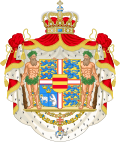
Palatinate-Neumarkt 1397–1448Oldenburg 1448–1863Christian I2 · John2 · Christian II2 · Frederick I · Christian III · Frederick II · Christian IV · Frederick III · Christian V · Frederick IV · Christian VI · Frederick V · Christian VII · Frederick VI · Christian VIII · Frederick VIISchleswig-Holstein-
Sonderburg-Glücksburgsince 1863Italics indicates Danish monarchs who were also monarchs of Norway.
1 Also monarch of England. 2 Also monarch of Sweden. 3 Also monarch of Iceland.Monarchs of Norway Fairhair dynasty · rival
rulers of other housesHarald I Fairhair · Eric Bloodaxe · Haakon I the Good · Harald II Greycloak · Haakon Sigurdsson 1 · Olaf I Tryggvason · Eiríkr Hákonarson 1 & Sveinn Hákonarson 1 & Hákon Eiríksson 1 · Sweyn Forkbeard · Olaf II the Saint · Hákon Eiríksson 1 · Canute the Great · Sveinn Álfífuson 1 · Magnus I the Good · Harald III Hardrada · Magnus II Haraldsson · Olaf III Kyrre · Haakon Magnusson & Magnus III Barefoot · Olaf Magnusson · Eystein I Magnusson · Sigurd I the Crusader · Magnus IV the Blind · Harald IV Gille · Sigurd the Noisy · Sigurd II Munn · Eystein II Haraldsson · Inge I Haraldsson the Hunchback · Haakon II Broadshoulder · Magnus Erlingsson · Sigurd Markusfostre · Olav the Unlucky · Eystein the Maiden · Sverre Sigurdsson · Jon Kuvlung · Sigurd Magnusson · Inge Magnusson · Haakon III Sverresson · Guttorm Sigurdsson · Inge II Bårdsson · Erling Stonewall · Philip Simonsson · Haakon IV Haakonsson · Haakon the Young · Magnus VI the Law-mender · Eric II Magnusson · Haakon V MagnussonKnýtlinga 985–995
1028–1035Fairhair dynasty · Sweyn Forkbeard 5 · Fairhair dynasty · Canute the Great 5 · Sweyn Knutsson 2 Fairhair dynastyBjelbo 1319–1387The Kalmar union 1387–1448Oldenburg 1448–1814Christian I 4 · John 4 · Christian II 4 · Frederick I 2 · Christian III 2 · Frederick II 2 · Christian IV 2 · Frederick III 2 · Christian V 2 · Frederick IV 2 · Christian VI 2 · Frederick V 2 · Christian VII 2 · Frederick VI 2 · Christian FrederickHolstein-Gottorp
Bernadotte1814–1905Schleswig-Holstein-
Sonderburg-Glücksburgsince 19051 Regent. 2 Also Danish monarch. 3 Also Swedish monarch. 4 Also Danish and Swedish monarch.5 Also Danish and English monarch. Categories:- 1577 births
- 1648 deaths
- People from Hillerød Municipality
- Danish monarchs
- Norwegian monarchs
- Dukes of Schleswig
- Dukes of Holstein
- House of Oldenburg
- Denmark–Norway
- Danish people of the Thirty Years' War
- Protestant monarchs
- Burials at Roskilde Cathedral
- Extra Knights Companion of the Garter
Wikimedia Foundation. 2010.


